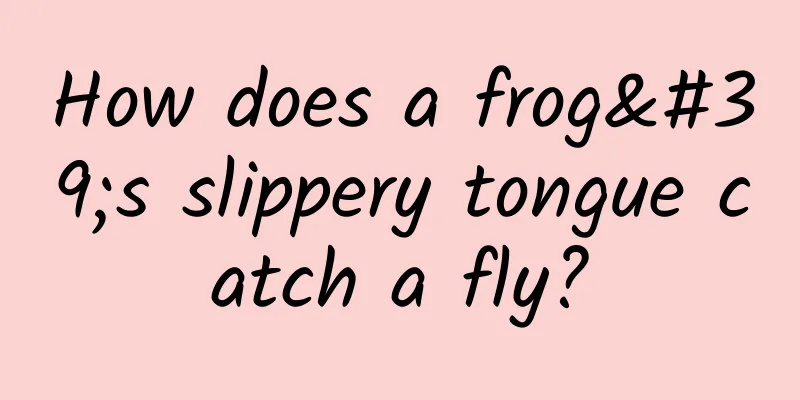How does a frog's slippery tongue catch a fly?

|
When it comes to frog hunting, the following scene will definitely come to your mind: a frog extends its long tongue, sticks to a fly flapping in the air with lightning speed, and then quickly retracts it into its mouth. Image source: gizmodo.com Even if you haven't seen it yourself, you should be familiar with this process, because this scene has been used many times to make popular science illustrations, small games, animation scenes, etc. Of course, there are also various funny videos. The inspiration for studying frog tongues came from a funny video. Frog research born from funny videos One day, Alexis C. Noel, a biophysicist at Georgia Institute of Technology, was surfing the Internet and saw a video like this: Video GIF. Image source: ThumbPress This video is very popular, at least in 2011, it was a hit, with 13 million views on YouTube. In just 26 seconds, a frog is sticking out its tongue to attack the ants on the phone screen, trying to eat them... An idea flashed through Noel's mind: How do frogs use their tongues to stick to insects so quickly? She thought this was a question worth studying. So the first thing Noel did was to run to the Atlanta Zoo and use a high-speed camera to film various frogs preying on insects. The unfortunate insect was a cricket. Image source: Document 1 By analyzing the video, she found that a frog can catch a cricket in 0.07 seconds. In other words, if it takes you 0.2 seconds to blink, then it can catch three crickets in the blink of an eye. Image source: Document 1 The frog's tongue is not only fast but also powerful. In this short moment, the acceleration of the tongue can reach 12 times the acceleration of gravity. In other words, when a small cricket is attacked by the frog's tongue, it is like being hit by a one-yuan coin. A cricket weighs only about 0.7 grams, and a coin is about 5 grams. If you were that cricket, the force you would feel would be equivalent to being pressed down by several 200-pound fat men. What's so magical about the sticky frog tongue? Everyone must be curious about what it feels like to touch a frog's sticky tongue. Noel was also curious. So she tested it with her hand, and it was indeed sticky. Image source: Document 1 Noel described it this way: It feels like marshmallow or chewed gum. The frog's tongue is sticky not because of the tongue itself, but because of the saliva secreted by the mucus glands on the tongue, which sticks like a hydrogel. So Noel and his colleagues took the sticky saliva from the mouths of various frogs and toads as experimental samples for testing. The thickness of this saliva is 7 times that of human saliva, with the thickest reaching 0.7mm. The right side is frog saliva, and the left side is a reference object. Image source: Reference 1 For further analysis, Noel took the tongue out of the frog mouth that he had dissected in college biology class, and then slowly scraped the saliva with a spoon. It took several hours just to get the saliva... Image source: Document 1 Then the saliva was put into a lamina rheometer (an instrument for testing liquid viscosity) for testing, and the results showed that the viscosity of the mucus reached 70pa/s. You may not be very sensitive to this value, but if you convert it, it means that the viscosity of frog saliva is 50,000 times that of human beings. Doesn't it feel scary... Image source: Document 1 The viscosity of frog saliva changes But in fact, frog saliva is only so sticky in certain situations, and not very sticky in other situations. Why is this so? Because the saliva has the properties of both fluid and solid. You may have heard of the concept of non-Newtonian fluid. In short, the faster it flows, the lower its viscosity. Yes, frog saliva is also a non-Newtonian fluid. When the frog sticks out its tongue and touches the cricket, the viscosity of its saliva decreases 100 times, and then the saliva completely wraps around the cricket and gets into every crevice of its body. When the frog's tongue began to pull back, relatively speaking, it was retracting much slower than it was stretching out, and at this point the mucus became very sticky, and the cricket was completely stuck to the tongue. It feels like you are painting a wall. If you paint the wall very quickly, it will feel smooth, but if you paint it too slowly, it will feel sticky. The question is, if saliva is so sticky, how do frogs swallow it? The answer is - using the eyeballs to help swallowing. Scientists used X-ray machines to observe the swallowing scene of frogs and found that when the cricket entered the frog's mouth, the frog had to let go of the cricket. A frog before swallowing a cricket. Image source: Reference 2 After the frog swallows the cricket, notice the change in the position of its eyeballs. Image source: Reference 2 At this time, the frog's eyeballs will retract, and the eye muscles will drive the closely connected oral muscles to push the food in to help swallowing. This is the secret of how frogs use their tongues to catch food. Why study such a "boring" thing? Frogs use saliva to catch prey, which seems to be a boring research. However, when it comes to this, we have to mention Noel's mentor Hu Lide, who is a professor who does boring research. For example, mammals pee for 21 seconds... He even won the Ig Nobel Prize. Someone asked him, isn't it a waste of money to do these studies? He responded: I am the most wasteful scientist in this country! Of course, it's just a joke. Back to the issue of frog predation, the most likely application of this research is to develop a reversible glue for high-speed bonding, that is, a glue that can achieve different viscosities by controlling the speed. When it is needed to stick things, it is the same as 502 glue, and it can immediately lose its stickiness when it needs to fall off. Some scientific research can be valuable immediately after it is done, which is called applied science; some scientific research may take ten or even dozens of years to be valuable, which is called basic science. Studying frog tongues belongs to the latter, which is the significance of studying "boring" science. References: [1] Noel AC, Guo HY, Mandica M, et al. Frogs use a viscoelastic tongue and non-Newtonian saliva to catch prey[J]. Journal of the Royal Society Interface, 2017, 14(127): 20160764. [2] Hammerman DL. 1969The frog tongue: I. General development and histogenesis of filiform papillae and mucous glands in Rana catesbeiana. Acta Zool. 50, 11–23. This article is produced by Science Popularization China, produced by Su Chengyu, and supervised by the Computer Network Information Center of the Chinese Academy of Sciences |
<<: Don't mess with me, I have a heat stroke...
>>: Export suspended! What exactly is natural sand?
Recommend
How can information flow control page design and reduce advertising waste?
A design that can stimulate users' desire to ...
Children can't run after congenital heart disease surgery? The truth is...
There are many opinions on whether children can e...
Wuxi Mini Program Agency Company, how much does it cost to be an agent for a real estate mini program?
What is the price of being an agent for Wuxi Real...
The road to "customized marketing" for online education in 2020
The battle for customer acquisition in online edu...
That's how you become a bad programmer.
[[133974]] It’s hard to be a good developer. Let’...
The Fly Restaurant, the Last Bite of Human Life in the Wave of Food Industrialization
Eating has been the eternal pursuit of mankind fo...
Dating requires IQ, staying up late will make people stupid
One minute with the doctor, the postures are cons...
The Zero Run incident happened again. Volvo test drive car's temporary license expired, causing the media person to be deducted 12 points
It has become an industry practice for manufactur...
Strategy for building a headline advertising account!
How to build a perfect information flow advertisi...
Android mobile ad revenue surpasses iOS for the first time
On May 6, mobile advertising platform Opera Media...
Drink juice or eat fruit? You may have been choosing the wrong one!
Fruits are nutritious and healthy, and are an ess...
The Shenzhou XII astronauts returned triumphantly. What effects will the three-month space environment have on the human body?
On the afternoon of September 17, the three astro...
Refusing to pick up a car may be a high probability event. Can SAIC Audi learn from Tesla in its channel competition?
"Dealers are now more united than ever befor...
Mao Xiaobai: Using video traffic to sell niche audio for cash, 5 videos a day to make money without supervision
Exclusive small project, the gameplay is first re...
Compared with fuel vehicles, do new energy vehicles have a higher rate of spontaneous combustion in collisions? How to prevent it in hot weather?
Spontaneous combustion of vehicles has always bee...









